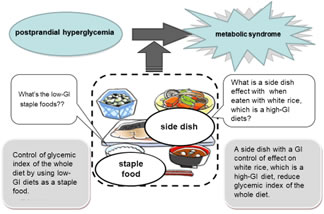Food Management

- account_circleYoko IchikawaPhD, RD, Prof.
- account_circleNaoko OtsukiRD, Research Asst. Prof
- Website:https://dfns.u-shizuoka-ken.ac.jp/labs/fmanage/
- Mail:ichity@u-shizuoka-ken.ac.jp
- Phone:+81-54-264-5512
Applied nutrition studies for specific food environments based on the results of basic nutrition research
Evidence-based practice and practice-based research on various phases of providing food for a long-lived society
- 1. Estimation of dietary intake of functional components from daily meals and methodology for designing enriched meals
Clinical studies of antioxidant supplements are currently underway but have not yet proven their safety and efficacy in long-term and high concentrations. Our research group examines the dietary intake of functional components such as flavonoids in Japanese adults; we have similarly created a database of these details in order to make recommendations related to getting antioxidants through food sources, rather than supplements, and to developing flavonoids enriched meals.
- 2. Effects of the food environmental arrangement and the food-service industry on individual dietary behavior
We analyze the effects of intervention by healthy home-meal replacement (HMR), on both consumer buying behavior and the financial health of these food companies. This methodology is based on marketing research into consumer needs.
- 3. Mechanisms of lowering Glycemic Index (GI) for mixed meals and evaluation methods of GI
Postprandial glucose level and insulin secretion are different between individual food and mixed meals. We investigate the interaction of food with the effect of reducing postprandial glucose and insulin, and seek methods of evaluating GI using kinetics for incretin secretion.
- Figure 1
- Concentration of quercetin in the blood after dietary intake flavonoid-rich meal.

- Figure 2
- Model of control postprandial hyperglycemia in Japanese diet.

References
- Apple. Physiol. Nutr. Metab., 44, 22-30 (2019)
- J. ARAHE, 23, 1-8 (2016)
- Biosci. Biotechnol. Biochem., 78, 1748-1752 (2014)
- Nutrition, 30, 69-74 (2014)
- Eur. J. Nutr., 52, 67-74 (2013)